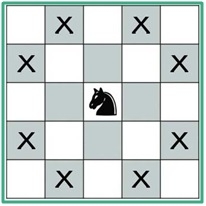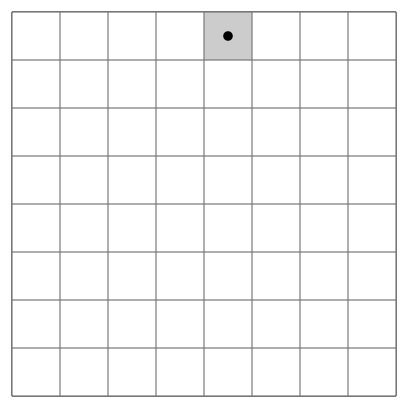标签:tour Knight solution --- item Tour knight problem
A Knight’s Tour
https://www.tutorialspoint.com/The-Knight-s-tour-problem
In chess, we know that the knight can jump in a special manner. It can move either two squares horizontally and one square vertically or two squares vertically and one square horizontally in each direction, So the complete movement looks like English letter ‘L’.
In this problem, there is an empty chess board, and a knight starting from any location in the board, our task is to check whether the knight can visit all of the squares in the board or not. When It can visit all of the squares, then place the number of jumps needed to reach that location from the starting point.
This problem can have multiple solutions, but we will try to find one possible solution.
Input and Output
Input: The size of a chess board. Generally, it is 8. as (8 x 8 is the size of a normal chess board.) Output: The knight’s moves. Each cell holds a number, that indicates where to start and the knight will reach a cell at which move. 0 59 38 33 30 17 8 63 37 34 31 60 9 62 29 16 58 1 36 39 32 27 18 7 35 48 41 26 61 10 15 28 42 57 2 49 40 23 6 19 47 50 45 54 25 20 11 14 56 43 52 3 22 13 24 5 51 46 55 44 53 4 21 12
https://bradfieldcs.com/algos/graphs/knights-tour/
The knight’s tour puzzle is played on a chess board with a single chess piece, the knight. The object of the puzzle is to find a sequence of moves that allow the knight to visit every square on the board exactly once, like so:
Solution
https://www.geeksforgeeks.org/the-knights-tour-problem-backtracking-1/
Backtracking works in an incremental way to attack problems. Typically, we start from an empty solution vector and one by one add items (Meaning of item varies from problem to problem. In the context of Knight’s tour problem, an item is a Knight’s move). When we add an item, we check if adding the current item violates the problem constraint, if it does then we remove the item and try other alternatives. If none of the alternatives works out then we go to the previous stage and remove the item added in the previous stage. If we reach the initial stage back then we say that no solution exists. If adding an item doesn’t violate constraints then we recursively add items one by one. If the solution vector becomes complete then we print the solution.
Backtracking Algorithm for Knight’s tour
Following is the Backtracking algorithm for Knight’s tour problem.
If all squares are visited print the solution Else a) Add one of the next moves to solution vector and recursively check if this move leads to a solution. (A Knight can make maximum eight moves. We choose one of the 8 moves in this step). b) If the move chosen in the above step doesn't lead to a solution then remove this move from the solution vector and try other alternative moves. c) If none of the alternatives work then return false (Returning false will remove the previously added item in recursion and if false is returned by the initial call of recursion then "no solution exists" )Time Complexity :
There are N2 Cells and for each, we have a maximum of 8 possible moves to choose from, so the worst running time is O(8N^2).Auxiliary Space: O(N2)
Code
https://www.tutorialspoint.com/The-Knight-s-tour-problem
#include <iostream>
#include <iomanip>
#define N 8
using namespace std;
int sol[N][N];
bool isValid(int x, int y, int sol[N][N]) { //check place is in range and not assigned yet
return ( x >= 0 && x < N && y >= 0 && y < N && sol[x][y] == -1);
}
void displaySolution() {
for (int x = 0; x < N; x++) {
for (int y = 0; y < N; y++)
cout << setw(3) << sol[x][y] << " ";
cout << endl;
}
}
int knightTour(int x, int y, int move, int sol[N][N], int xMove[N], int yMove[N]) {
int xNext, yNext;
if (move == N*N) //when the total board is covered
return true;
for (int k = 0; k < 8; k++) {
xNext = x + xMove[k];
yNext = y + yMove[k];
if (isValid(xNext, yNext, sol)) { //check room is preoccupied or not
sol[xNext][yNext] = move;
if (knightTour(xNext, yNext, move+1, sol, xMove, yMove) == true)
return true;
else
sol[xNext][yNext] = -1;// backtracking
}
}
return false;
}
bool findKnightTourSol() {
for (int x = 0; x < N; x++) //initially set all values to -1 of solution matrix
for (int y = 0; y < N; y++)
sol[x][y] = -1;
//all possible moves for knight
int xMove[8] = { 2, 1, -1, -2, -2, -1, 1, 2 };
int yMove[8] = { 1, 2, 2, 1, -1, -2, -2, -1 };
sol[0][0] = 0; //starting from room (0, 0)
if (knightTour(0, 0, 1, sol, xMove, yMove) == false) {
cout << "Solution does not exist";
return false;
} else
displaySolution();
return true;
}
int main() {
findKnightTourSol();
}
标签:tour,Knight,solution,---,item,Tour,knight,problem 来源: https://www.cnblogs.com/lightsong/p/16392906.html
本站声明: 1. iCode9 技术分享网(下文简称本站)提供的所有内容,仅供技术学习、探讨和分享; 2. 关于本站的所有留言、评论、转载及引用,纯属内容发起人的个人观点,与本站观点和立场无关; 3. 关于本站的所有言论和文字,纯属内容发起人的个人观点,与本站观点和立场无关; 4. 本站文章均是网友提供,不完全保证技术分享内容的完整性、准确性、时效性、风险性和版权归属;如您发现该文章侵犯了您的权益,可联系我们第一时间进行删除; 5. 本站为非盈利性的个人网站,所有内容不会用来进行牟利,也不会利用任何形式的广告来间接获益,纯粹是为了广大技术爱好者提供技术内容和技术思想的分享性交流网站。


